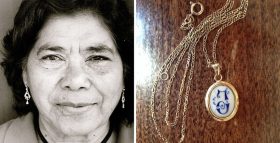“Is that a family heirloom?” a woman asked, as she inspected the necklace that I’ve worn every day for the past four years. She was looking for was a one-word answer: yes or no. But it wasn’t that simple.
The pendant is unusual, with a monogrammed Mediterranean tile on one side and black onyx with a speck of a diamond in the middle on the other. I wear it in memory of my childhood nanny, but its origins, much like our relationship, are complicated.
María Faustina Calderon, whom my brothers and I called Tina, spent 34 years caring for my family in Washington, D.C. She’d lived with them before I arrived, and looked after my mother long after my brothers and I, then my father, moved out.
Related
In high school, we bickered the way many of my friends did with their parents. She didn’t get why I went away for college. I explained that I’d meet a nice guy there, since she really just wanted me to casarme and bear niños. That said, she didn’t care for my admittedly underwhelming boyfriends and insisted I deserved better. We talked on the phone weekly, sent each other cards, and she visited me a couple times when I moved to New York.
I never had a chance to say goodbye to Tina. Or rather, I didn’t realize that the last time I’d seen her was goodbye. Six months after my last visit home in 2009, my mother found Tina unconscious in the basement. She was 72. My little brother called an ambulance.
For days, our family, as well as Tina’s cousin, goddaughter, and various friends from her church, waited for her to emerge from her coma. I’d squeeze into her narrow hospital bed and hold her hand and kiss her face. If her foot so much as twitched, I saw it as a sign. But her liver had given out. Her heart followed suit. She was not eligible for any transplants. It was time to pull the plug. So I carefully packed up her belongings, as if she were moving homes instead of being transferred from an ICU to a coffin.
Tina didn’t own much: a couple sweatshirts, stretch waist polyester pants and size 5 wide, worn orthopedic shoes. Her one vanity, for lack of a better word, was religious paraphernalia. I sorted through dozens of rosaries, Jesus images, bibles, and 40-odd crosses in her windowless, basement bedroom. I set aside a small bottle of her holy water to put in her coffin. She had gotten it on her favorite trip, to Israel, with her church group. As a kid, I’d pretended to be drunk off it. “Don’t be obnoxious,” she’d say in Spanish, as she snatched it back. Her cousin María had instructed me to remove anything from the coffin, as it could be stolen, but I pinned the holy water bottle to Tina’s blouse.
I’d also found a little jewelry box I’d given her ages ago. Inside was this garish ring that I’d had a jeweler redesign for Tina when I was X, with a fat diamond encrusted amethyst set in white gold. I handed it to María, in hopes that she’d pawn it for a couple hundred bucks. The religious tchochkes went to her family, friends, and church. I kept the pendant, with the ocean blue letter painted in script, which I wore religiously and assumed it was a T for Tina.
Years after her coffin was sent back to Nicaragua, I’d still wake up crying. I’d clutch the pendant the way a kid clings to a binky blanket. I’d look at photos and re-read Tina’s tender cards to me, but that necklace let me feel Tina physically close to my heart.
Initially, when strangers asked, I’d say it belonged to my childhood nanny. Some guy I went on a date with questioned how “a maid” could afford such a nice piece. (There was no second date.) Sometimes people, even friends, would simply inform me that my loss didn’t compare to their own experiences. To them Tina was paid to care for me. I knew she chose to love me.
Still, I couldn’t remember seeing Tina actually ever wearing this necklace. Since it was in the same small box as that ring I just assumed it was something I’d given her. I often gave Tina my own clothes and jewelry and my mother’s as well, much to her chagrin: when my mom first saw it around my neck, she barked, “You stole that from me. It was Grandma Joan’s!”
Ordinarily, I might have been defensive. My mother and I had a fraught relationship (hence I’d found refuge with Tina). Yet I understood that my mom missed her too, and that her memory was as unreliable as my own. So I inspected the necklace to see if the “T” looked like a “J.” Sure enough, at second glance, it could be a “J.”
What if it didn’t belong to Tina? (Luckily) I’d loved my Grandmother Joan, who had died after a long battle with Alzheimer’s nearly fifteen years prior. Whether the pendant was originally hers or Tina’s wouldn’t bring either of them back. Much like my family, the story wasn’t straightforward. But now when someone asks if the necklace is a family heirloom, I simply say sí.
Catie Lazarus is a writer and host of the critically acclaimed podcast Employee of the Month Show. She tweets from @catielazarus.












